![How Can Starling Bank Drive SEO Growth in 2024? [Untapped Potential Issue #2]](https://digitaloft.co.uk/wp-content/uploads/2024/05/starling-bank.png)
This deep dive is part of our Untapped Potential newsletter, where we reveal the SEO tactics we’d deploy to unleash the untapped potential of a different brand every week. Sign up to get more content just like this straight into your inbox every Wednesday.
Starling Bank, a British challenger bank, already drives almost half a million monthly sessions through organic search, but less than 36% of this comes from non-brand terms (180k sessions per month).
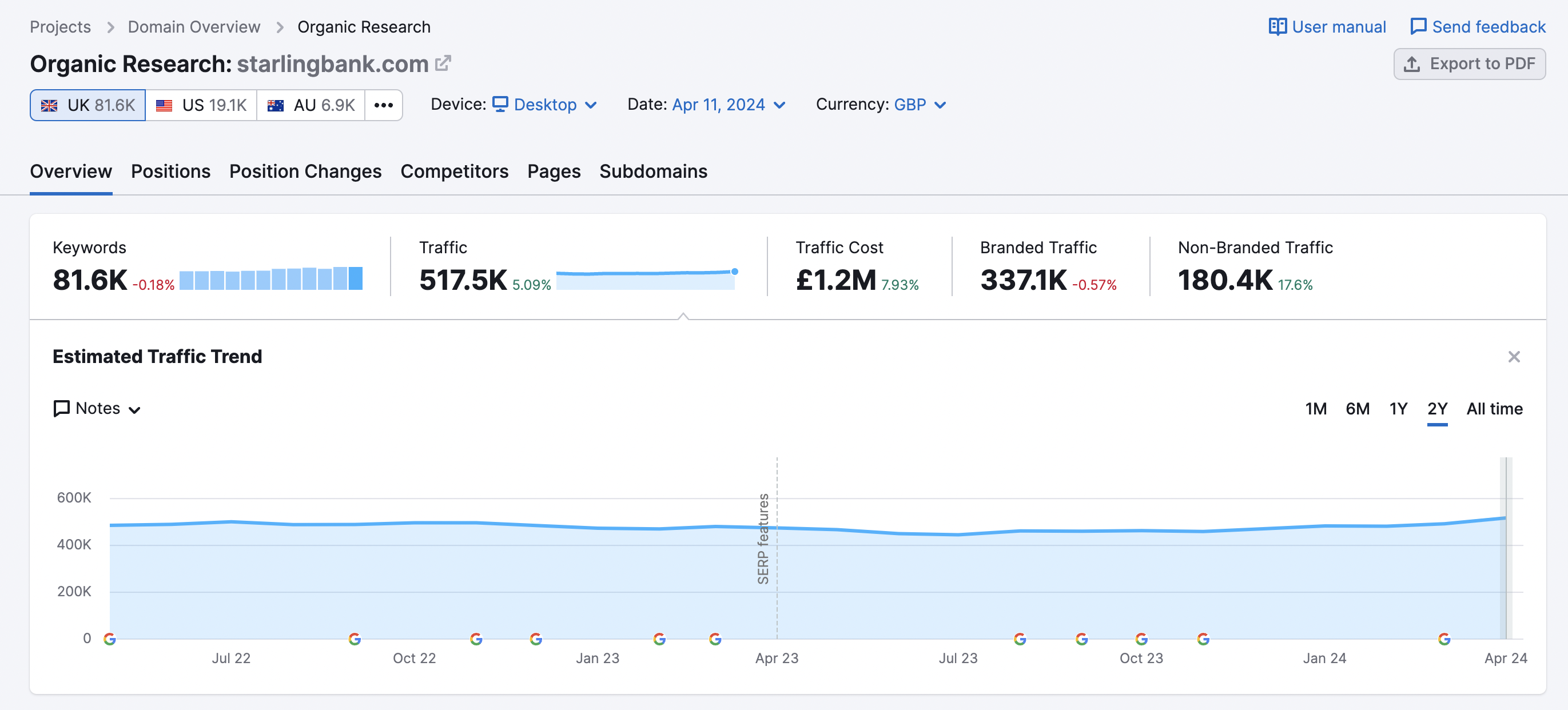
And in this deep dive, I want to take a look specifically at how Starling Bank can kickstart an upward trend in non-brand organic traffic growth and take a larger share of this incredibly competitive but large market in 2024.
The reality is that Starling could be driving a lot more non-brand traffic via its SEO efforts, and I’ve spent time digging deep into the site’s current performance, SEO tactics and competitive landscape to put together a look at exactly what steps I’d take, and what I’d prioritise, to increase its share in the market.
Keep reading to learn about these opportunities and how I’d leverage them to take organic performance to an all-time high in 2024.
Starling Bank: A Quick Background
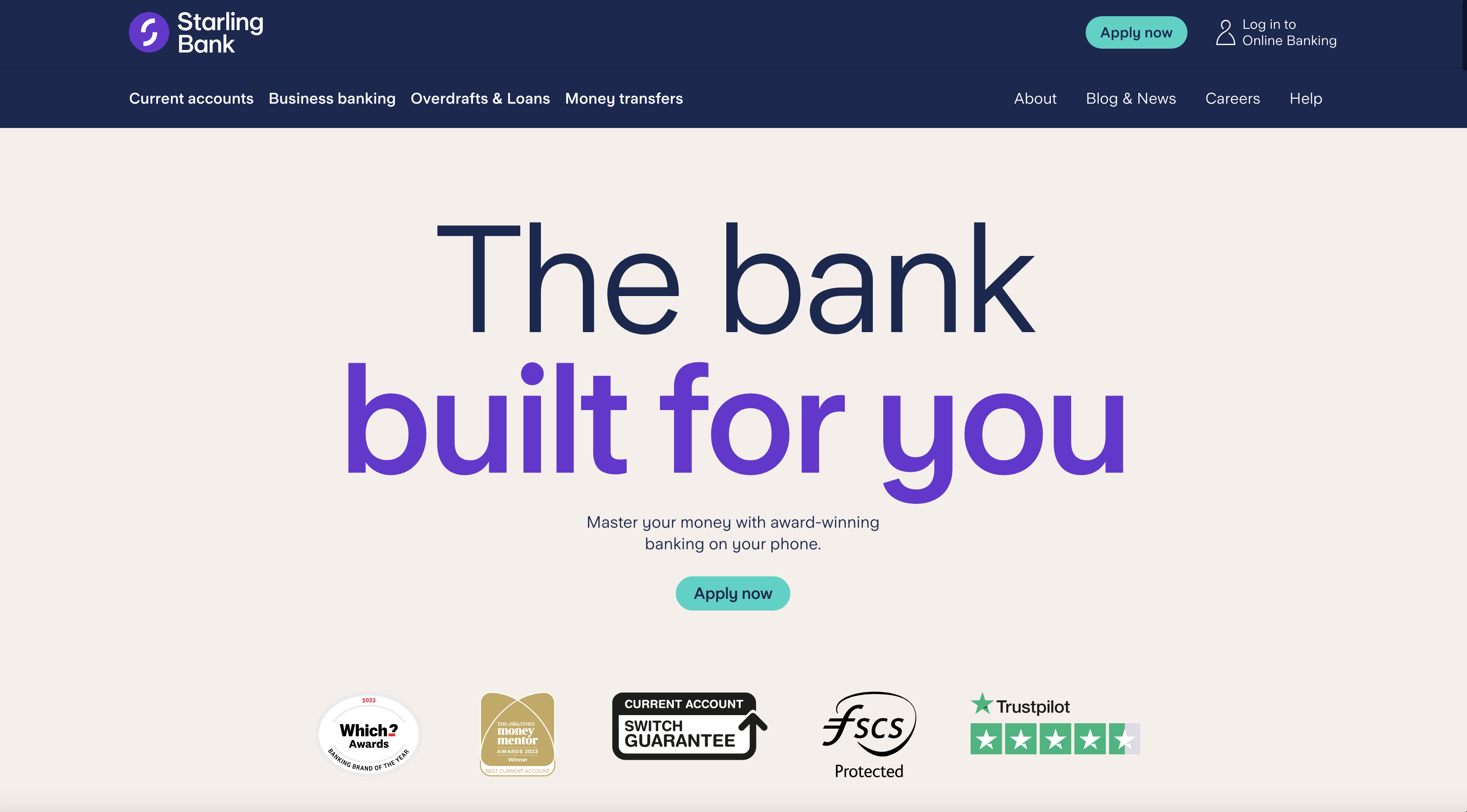
Don’t know who Starling Bank is? Here’s a quick background to give you the context you need to know about the brand.
- A British challenger bank with a vision of “Fast technology, fair service and honest values. All at the tap of a phone, all the time.”
- Britain’s first digital bank.
- The only bank in British history that’s been founded by a woman.
- Obsessed with changing banking for good.
- Over four million accounts and four different account types.
- App-based banking at its best.
Benchmarking Starling Bank’s SEO Performance
Let’s take a look at how Starling Bank performs on the SERPs across non-branded traffic and rankings.
Here are some of the top traffic-driving rankings that Starling Bank holds right now.
| Keyword | Monthly Search Volume | Ranking Position |
|---|---|---|
| Sort Code | 22,200 | 1 |
| BACS Payment | 14,800 | 1 |
| Gross Profit | 12,100 | 1 |
| Business Bank Account | 12,100 | 1 |
| Business Account | 8,100 | 1 |
| Business Loans | 14,800 | 7 |
| Bank Account | 14,800 | 3 |
| Online Bank | 3,600 | 1 |
| Child Bank Account with Debit Card | 2,400 | 3 |
| Cost of Sales | 2,400 | 1 |
| Kids Bank Account | 8,100 | 2 |
| Joint Account | 6,600 | 5 |
| Sole Trader Bank Account | 1,300 | 1 |
| Account Number | 8,100 | 4 |
| Bank Statement | 6,600 | 5 |
| Bank Account with Overdraft | 1,300 | 4 |
Starling Bank already holds some impressive rankings. Especially for ‘business account’ and ‘kids account’ related terms.
But how about their visibility for the terms where they could be doing better?
| Keyword | Monthly Search Volume | Ranking Position |
|---|---|---|
| Travel Card | 12,100 | 39 |
| Best Current Account | 12,100 | 10 |
| Current Account | 9,900 | 10 |
| Open Bank Account Online | 9,900 | 11 |
| Joint Bank Account | 8,100 | 7 |
| Travel Money Card | 8,100 | 24 |
| Fixed Rate Savings | 8,100 | 40 |
| Business Savings Account | 4,400 | 26 |
| 1 Year Fixed Rate Savings | 2,400 | 23 |
| Send Money Abroad | 1,900 | 6 |
| Compare Current Accounts | 1,600 | 15 |
| What Do You Need to Open a Bank Account? | 1,600 | 93 |
| Current Accounts with Interest | 1,300 | 7 |
| How Many Current Accounts Can I Have? | 1,000 | 47 |
Here, I’ve looked at keywords that currently rank outside the top 5 positions. After all, anything below here is unlikely to receive a significant number of clicks.
Whilst Starling Bank has some awesome visibility, there are also a lot of opportunities to increase this across the pages and queries that aren’t performing quite as strongly right now.
And that’s exactly what I want to look at below…
Accelerating SEO Success: Starling Bank’s SEO Opportunities
It’s so easy to become complacent with SEO once you start to see some wins. After all, if traffic and conversions are increasing, surely what you’re doing is working?
I get it.
It’s easier to find the opportunities on a site that isn’t doing so well on the SERPs. These are often staring you right in the face.
But when you are seeing success from the channel, it takes a bit more digging and analysing to figure out where to go next.
And I’ve spent time diving deep into Starling Bank’s organic performance to do just that; put forward my suggestions on the opportunities that exist for the site’s visibility to keep growing.
There’s a great foundation in place, but organic could be doing even more for the site.
These recommendations aren’t the only SEO opportunities that exist. These are a series of opportunities that I identified whilst analysing the site, all discovered without access to first-party data from Google Analytics or Google Search Console.
Here’s where I’d focus my efforts if I were responsible for Starling Bank’s SEO strategy…
1. Improve E-E-A-T signals
E-E-A-T (Experience, Expertise, Authoritativeness, Trustworthiness) matters a lot.
Especially for YMYL sites.
And Starling Bank definitely falls into this category.
But despite this, there are an awful lot of opportunities that can be leveraged to improve the way E-E-A-T is demonstrated across the site. And this is where I’d begin to focus my efforts.
Not necessarily because I think the site is being held back by this right now, as there’s no evidence of that, but because of Google’s ongoing commitment to doubling down on ranking content that’s been produced by content creators with experience and/or expertise.
I’m largely talking about informational content in the context of Starling Bank’s E-E-A-T signals, by the way.
E-E-A-T is going to become even more important over the next year, in my opinion.
So how can Starling Bank better demonstrate E-E-A-T?
Let’s start by looking at an example of the site’s informational content, their guide on “How to improve your credit score when renting?“
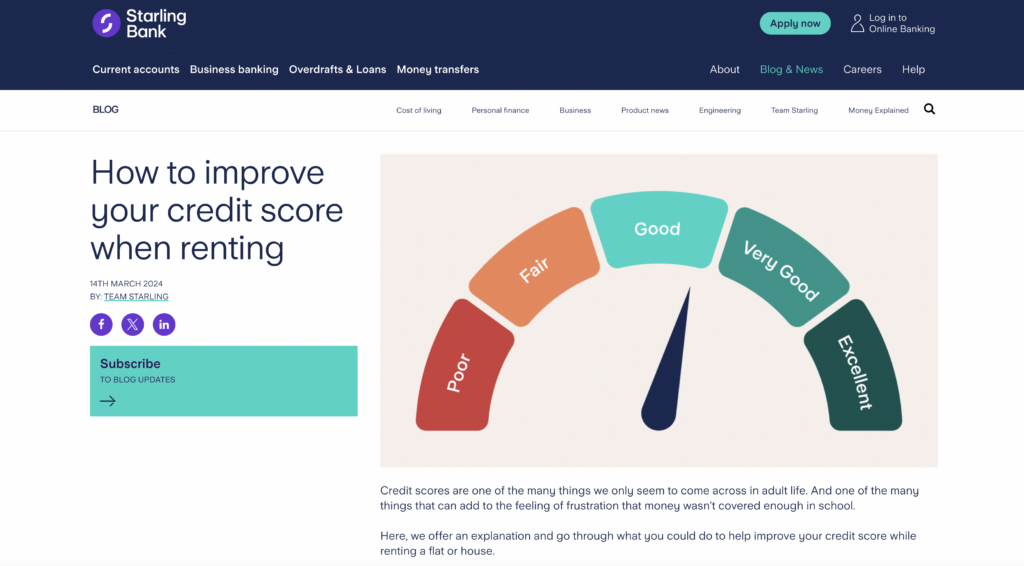
The first thing that stands out to me is that it’s published by “TEAM STARLING.”
In my opinion, this is a mistake.
Content should pretty much never be assigned to a team, almost always an individual, as far as I’m concerned, unless it’s crystal clear who that team consists of.
My first rule of improving E-E-A-T for a site is to ask whether it’s easy to find out who is behind any piece of content. It’s the absolute basics.
In this case, it’s not. Yes, I know the team, but not the individuals who actually created the content. What is their experience? What’s their level of expertise? These things matter.
To start with, change out the author. This should be an individual on Starling’s team. I’d also recommend adding a short bio to the page below the author’s name there in the left-hand sidebar. There’s the perfect space for an improved’ author box’ right there above the fold. On mobile, this should likely move to below the main content.
This author box should clearly include the author’s:
- Name
- Job title
- Profile picture
- Short bio
- Profile page link
From there, let’s look at the site’s author pages.
I won’t review the fraud team’s page because these profiles should be for individuals.
Instead, I’ll look at Charlotte Lorimer’s.
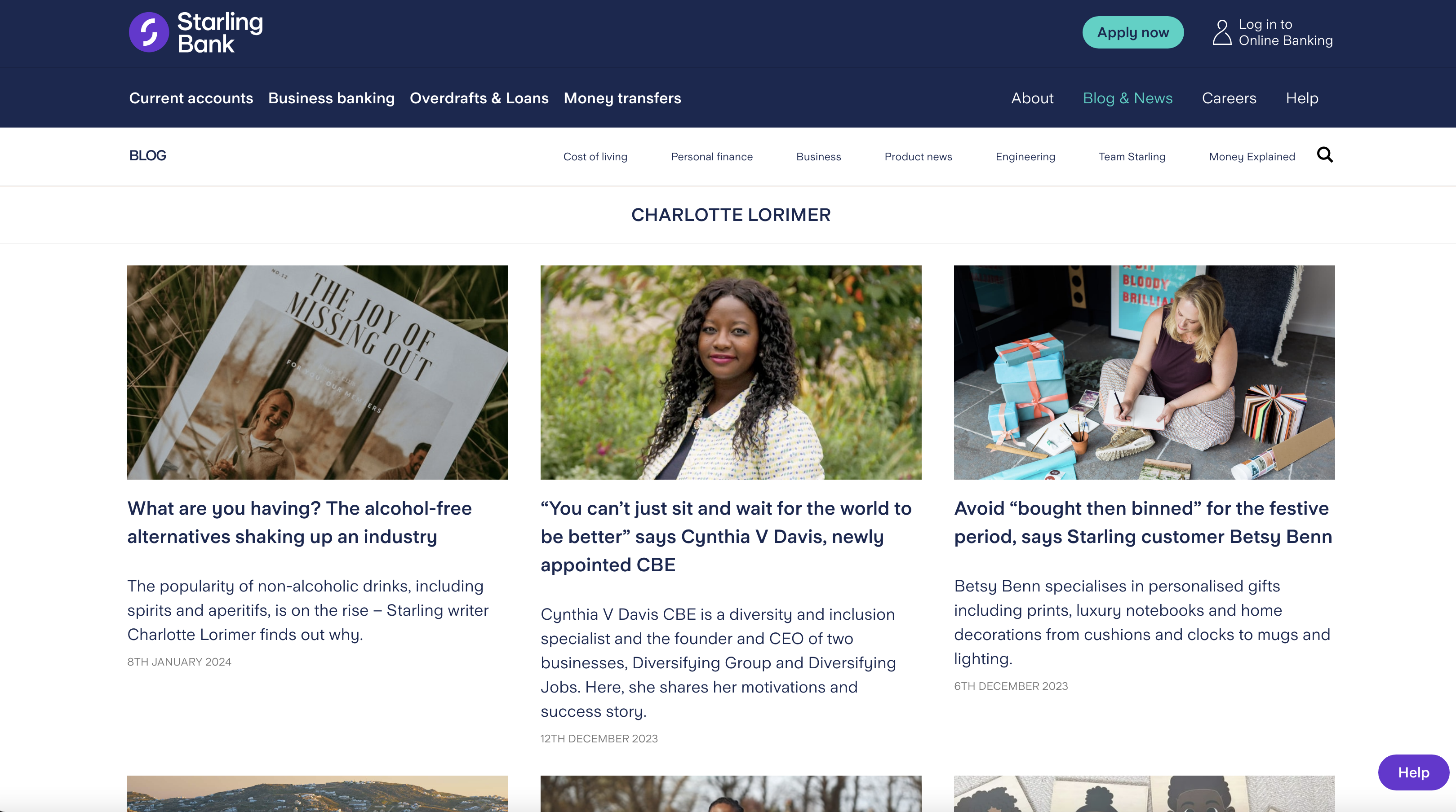
Starling Bank’s author profile pages need a lot of work. They’re nothing more than the author’s name and a feed of their posts at the moment.
As an absolute baseline, these should include:
- The author’s name
- The author’s job title
- A detailed bio for the author, including a summary of their experience (including educational, where appropriate)
- Their areas of expertise
- Links to their social platforms
- The content they’ve authored on the site
- Schema markup to reference the above
Starling’s author pages, right now, include only the author’s name and links to the content they’ve published on the site.
We can learn absolutely nothing about who the authors are from these pages, and for a YMYL site, this isn’t good enough.
Take a look at our guide to author page examples that brilliantly demonstrate E-E-A-T to learn more about how these pages could be improved.
Starling should also be using their own subject matter experts to add value to informational content through quotes, comments and tips.
In fact, leveraging experts within content is one of the most effective things that can be done to effectively demonstrate E-E-A-T.
Think about it as a consumer.
Would you trust tips about saving money, a guide to understanding a financial scam or recommendations on the best account for your kids from an experienced finance professional more than that published by “Team Starling”?
Of course you would.
E-E-A-T is about helping users to trust you and your content which, in turn, correlates with search engines trusting you.
Top tip: These subject matter experts should also be used as spokespeople in PR activity around their areas of expertise, but more on that soon
2. Help the site’s informational content work harder as a traffic-acquisition channel
Much of Starling’s informational content could be working harder to drive traffic to the bank’s site.
And by working harder, I mean ranking higher or for a wider number of relevant terms.
In fact, the estimated traffic to Starling’s blog has dropped by 64% since its peak in April 2022.
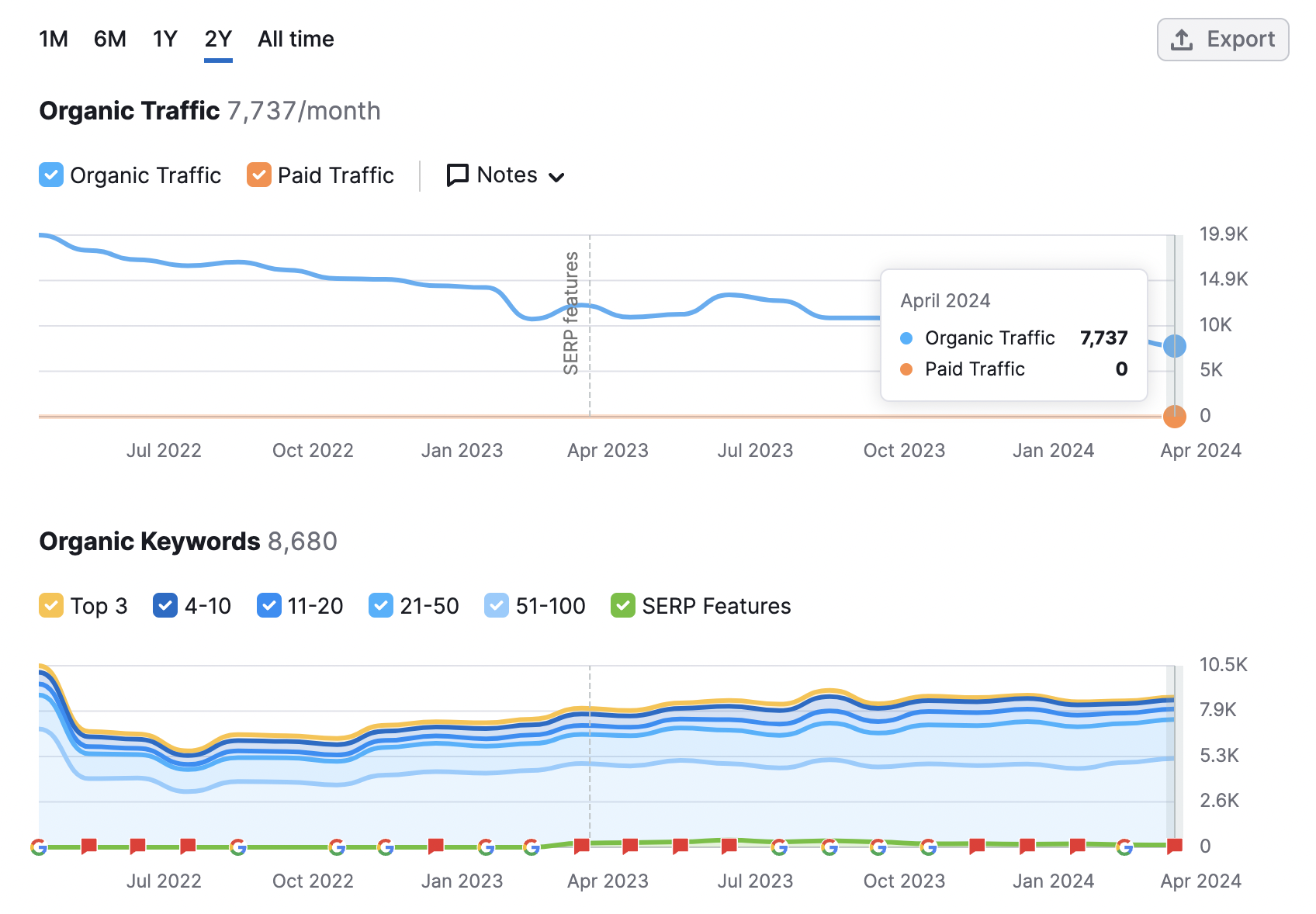
This is all the evidence that’s needed to highlight the opportunity to improve, update and optimise this content.
Here are a few examples of content that could be performing better:
| URL | Main Keyword | MSV | Rank |
|---|---|---|---|
| https://www.starlingbank.com/blog/50-30-20-budgeting-rule-is-it-realistic-in-a-cost-of-living-crisis/ | 50 30 20 Rule | 2,900 | 10 |
| https://www.starlingbank.com/blog/debit-card-or-credit-card-what-is-better/ | Credit Card vs Debit Card | 720 | 26 |
| https://www.starlingbank.com/blog/how-to-avoid-card-charges-abroad/ | Using Debit Card Abroad | 1,000 | 30 |
| https://www.starlingbank.com/blog/how-to-send-money-abroad-bank-less/ | How to Send Money Abroad | 480 | 39 |
| https://www.starlingbank.com/blog/best-age-to-start-giving-children-pocket-money/ | How Much Pocket Money UK | 260 | 19 |
| https://www.starlingbank.com/blog/zero-based-budgeting/ | Zero Based Budgeting | 1,600 | 15 |
| https://www.starlingbank.com/blog/what-is-a-chargeback-and-how-does-it-work/ | What are Chargebacks? | 390 | 10 |
3. Launch a content hub for ‘personal finance’ in place of the blog
At the moment, all of Starling Bank’s informational content sits within the blog.
But I’m not usually the biggest fan of a blog being used as a place to house informational and educational content, and there could be huge benefits here to breaking this content out into:
- A personal finance content hub
- A business hub (the ‘business guides‘ hub already exists)
- A news feed
A blog, by default, is usually a list of ‘latest posts’ sorted by the most recent first. And this usually means that older content can quickly get buried deep into pagination. From an SEO perspective, this means the content ends up deeper into the site’s structure, more clicks away from the homepage and inherits less PageRank.
But when a key part of most SEO strategies is evergreen informational content, does it really make sense for this to be published amongst news content, company updates and similar?
Not if there’s a better alternative.
Now for a small business, publishing a mix of news content and evergreen content on the blog will always be the easiest and most cost-effective option.
For Starling Bank, though, I’d recommend breaking the existing blog content out into dedicated content hubs for ‘Personal Finance’ and ‘Business.’ And then have a separate ‘news’ section for company news, product updates and the like.
The ‘business guides’ section already exists, and there’s justification for merging the ‘business’ blog content into this; the features on specific businesses and the like could even become its own site section.
In fact, just look at the growth that this resource hub has seen in recent years, further justifying why this approach makes sense for ‘personal finance’ too:
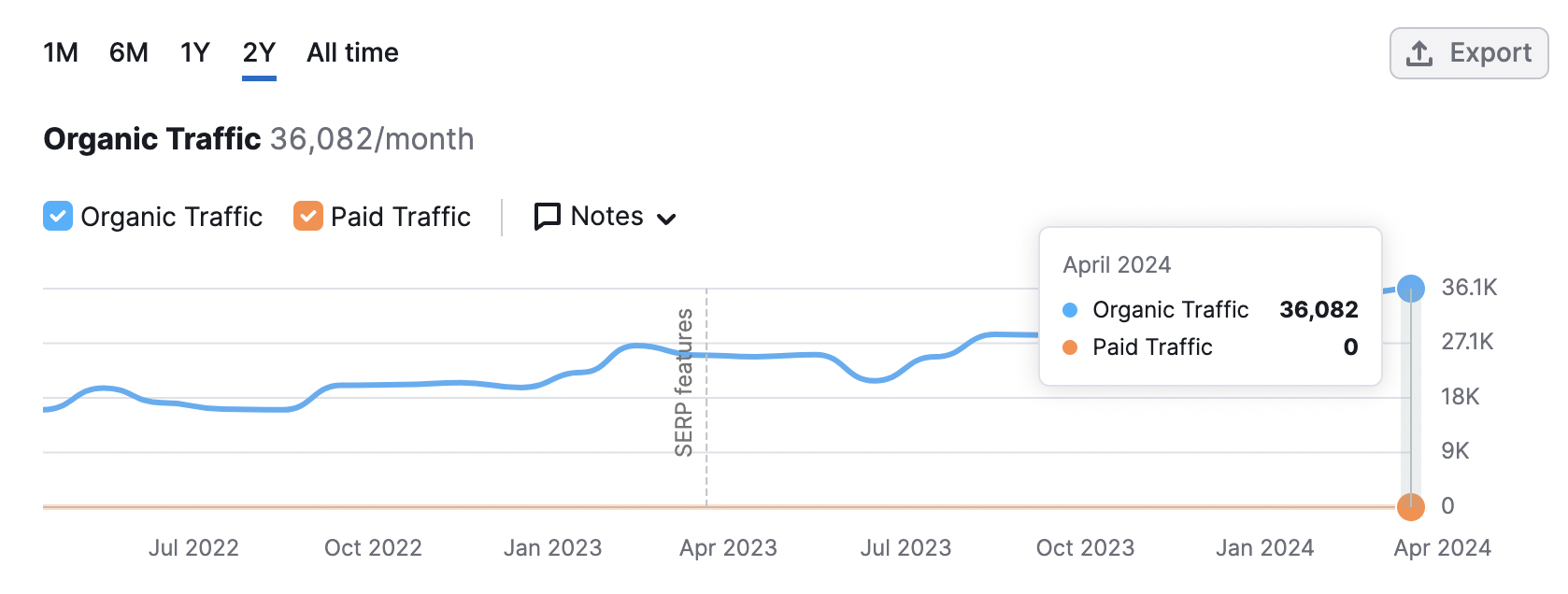
This isn’t a straight-up SEO recommendation, though. This is all about helping the content that needs to be seen in front of users who don’t necessarily come to it straight from the search engines.
I’m a huge fan of this blog post by Ross Hudgens that perfectly sums up the reason why most blogs aren’t being used effectively as SEO tools:
We should think of our blogs, or rather our content sections, as a library—more of an organization of useful information that solves problems.
Ross Hudgens
A content hub should be based on helping the audience, and a standard list of posts sorted from newest to oldest doesn’t do this, not even with categorisation.
Starling Bank has an opportunity to reconsider the setup of its current blog, breaking this out into dedicated content hubs that better support each of the business’s main functions and help to get the right content in front of the right audiences.
4. Close content gaps against SERP competitors
Starling Bank has a content gap with its main SERP competitors, and this should be closed to take away market share.
In simple terms, competitors have created content (that’s ranking) around topics that Starling hasn’t created.
To rank for a keyword, you need to have relevant content that matches the intent of that query. It’s as simple as that.
And until Starling goes ahead and closes these content gaps, the site will struggle to rank for these terms.
Wanna see some of the content gaps that exist? Here are some examples of gaps that Starling needs to close:
| Keyword | MSV | Rank |
|---|---|---|
| How Long is a Cheque Valid For? | 2,400 | 100+ |
| What Do You Need to Open a Bank Account? | 1,600 | 93 |
| How Many Current Accounts Can I Have? | 1,000 | 64 |
| Does Overdraft Affect Credit Score? | 1,300 | 95 |
| How Often Can You Switch Bank Accounts | 590 | 24 |
| Current Account vs Savings Account | 480 | 52 |
| How to Get Out of Overdraft | 390 | 48 |
| Debit Card Protection | 260 | 69 |
| Can You Transfer Overdraft Money to Another Account? | 260 | 100+ |
| Bank Account Types | 170 | 20 |
These are just a handful of content gap opportunities I found surrounding Starling Bank’s current account product. There are many more I could have suggested, as well as ones around business banking.
In fact, to show just one opportunity on how Starling Bank’s business content can be expanded, let’s compare their page with Tide’s page that ranks for the query “net profit margin formula.” What’s interesting is that Starling ranks way higher than Tide for “net profit,” however, when we get to more granular queries, these need their own page to match the intent, which Starling doesn’t have.

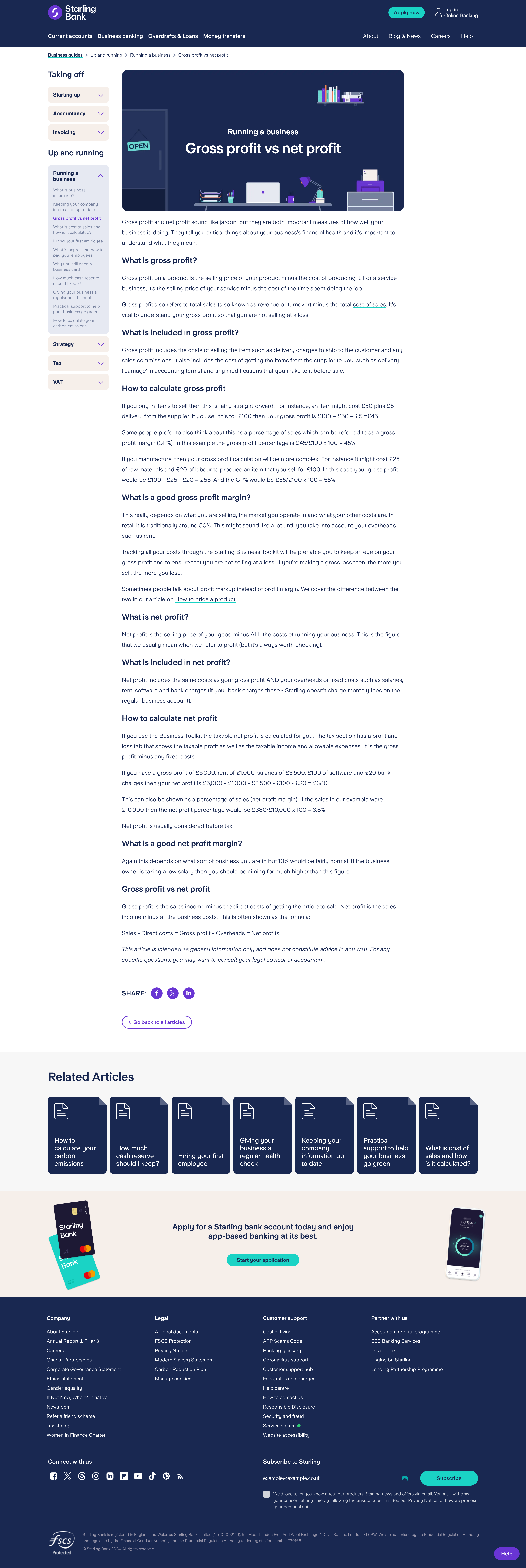
Starling Bank has a big opportunity here to further expand its content and earn increased rankings and traffic as a result.
One proven way to increase organic traffic right across the funnel, meaning that awareness is being increased, as well as direct conversions, is to close content gaps. This is also key to building out supporting content to help drive the rankings of primary commercial keywords, too, by building topical authority.
This is an opportunity that’s just waiting to be leveraged, and a content strategy is needed to identify what the full list of opportunities looks like, and a plan put in place to write and publish these pieces.
5. Leverage informational content & expert insights to earn relevant links from the press
Digital PR is something that every brand should be doubling down on in 2024.
And it’s not just about links.
If I head to Google News and search for Starling Bank, here’s what comes up:
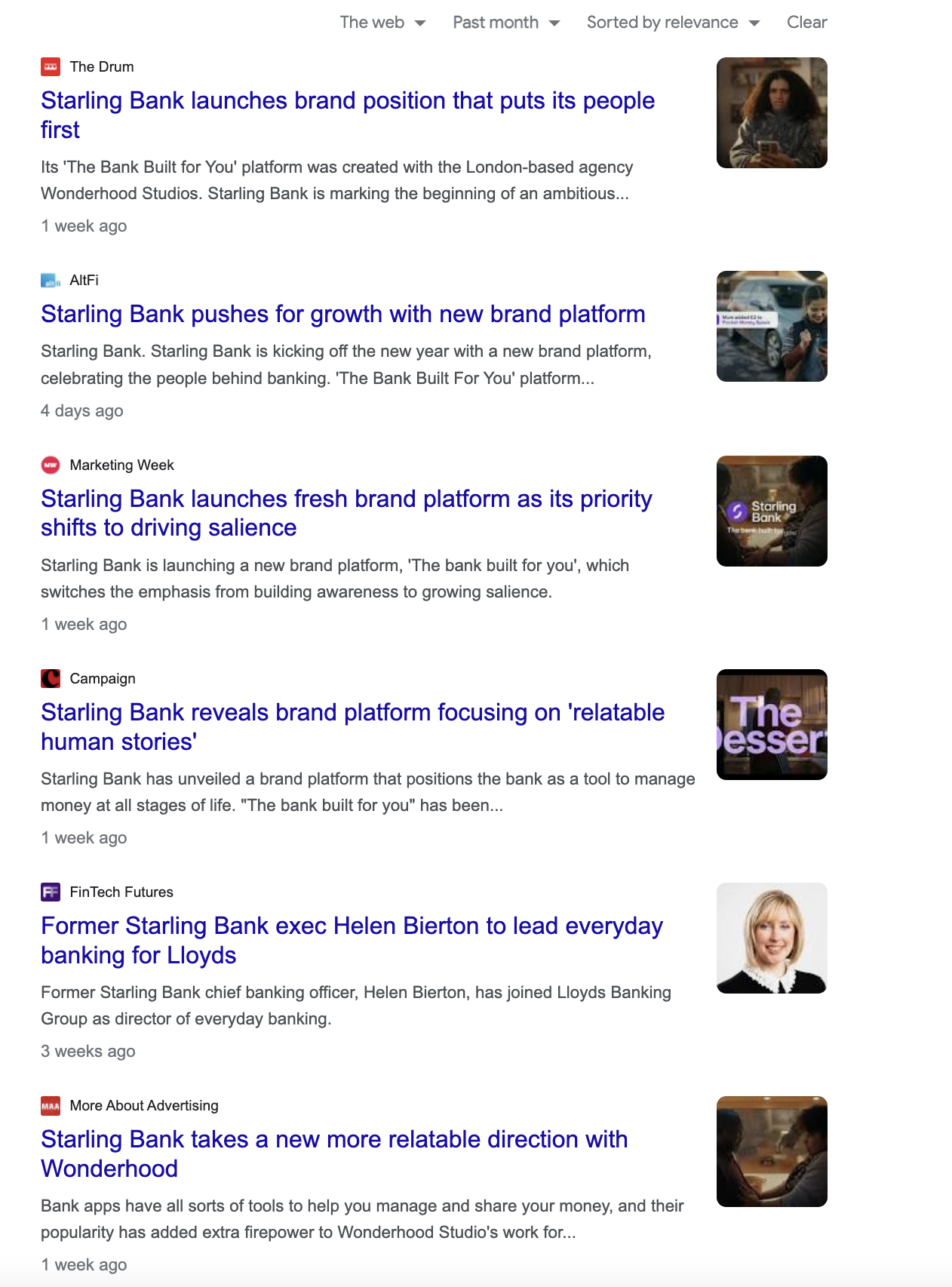
So this is only a handful of pieces of press coverage that feature Starling from the last month, but whether I keep on scrolling or go back further, it’s a pretty similar picture.
And that’s that most of Starling’s coverage in the press is about their advertising campaigns or straight-up brand PR.
This is great, but there are so many more opportunities outside of this that likely aren’t being leveraged as effectively as possible.
And that’s using both existing informational content from the site’s blog and tips and comments from their experts to offer expert insights to journalists, both proactively and reactively.
In fact, personal finance (and business finance, for that matter) is the perfect sector for this type of digital PR, especially given how important it is that journalists utilise the insights from experts in their articles. After all, offering financial tips and advice is something that should always come from an expert.
This is a tactic that we leverage so effectively at Digitaloft for our personal finance clients, using comments and tips from their experts to add value to journalist’s content.
Here are just two examples of linked coverage earned by our digital PR team on the back of tips from one of our personal finance clients, Money.co.uk.
Here’s coverage we earned on the Express with recommendations on the best ISA rates:
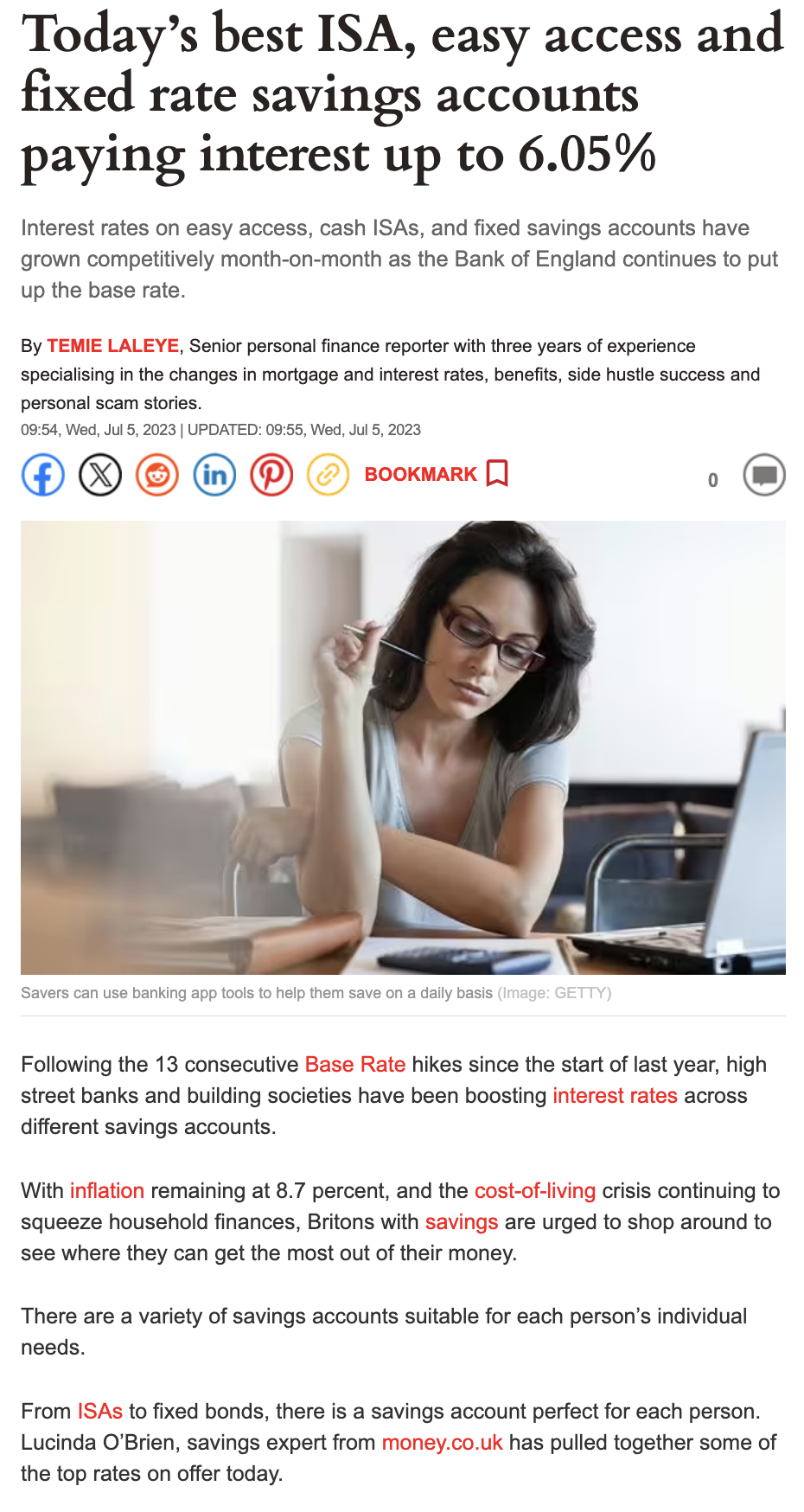
And here’s another example of tips on doing a food shop on a budget during the cost of living crisis, which landed syndicated coverage across Nottinghamshire Live and the wider regional network it’s a part of:
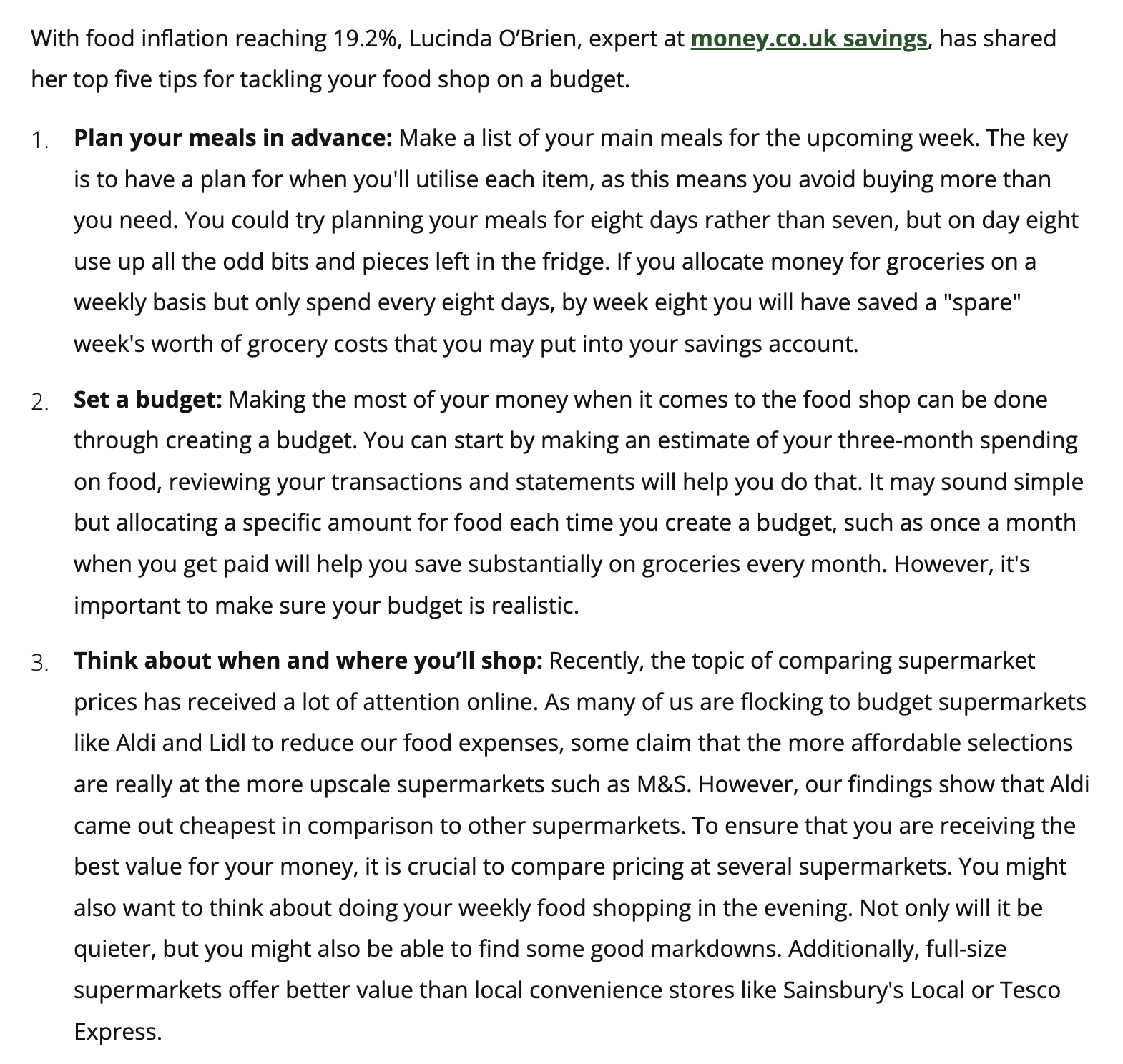
Starling Bank should position itself as a voice around all things current accounts, business accounts and personal finance in general, and this could be based on pitching out the tips that have been published on the site’s blog as a starting point.
Here are three posts that could be turned into expert insights pitches:
- What’s the best age to start giving children pocket money, and how much?
- “My friend has owed me money for eight years. I asked two experts for advice.”
- Staying safe from online shopping scams
All of these are the perfect type of content that can be repurposed to land press coverage and links; just make sure to attribute the insights to a subject matter expert.
This is a huge opportunity for Starling Bank, and should be seen not only as a way to earn incredibly relevant links but also to get the bank in front of an audience consuming personal finance content, getting them in on the conversation as a major voice.
When we do look at this as a straight-up link gap opportunity, we see that Monzo’s referring domain count outpaces Starling’s right now. Digital PR, as far as I’m concerned, is the way to close this gap somewhat and a focus on relevancy will, without a doubt, allow Starling to outperform without needing to outpace on link numbers.
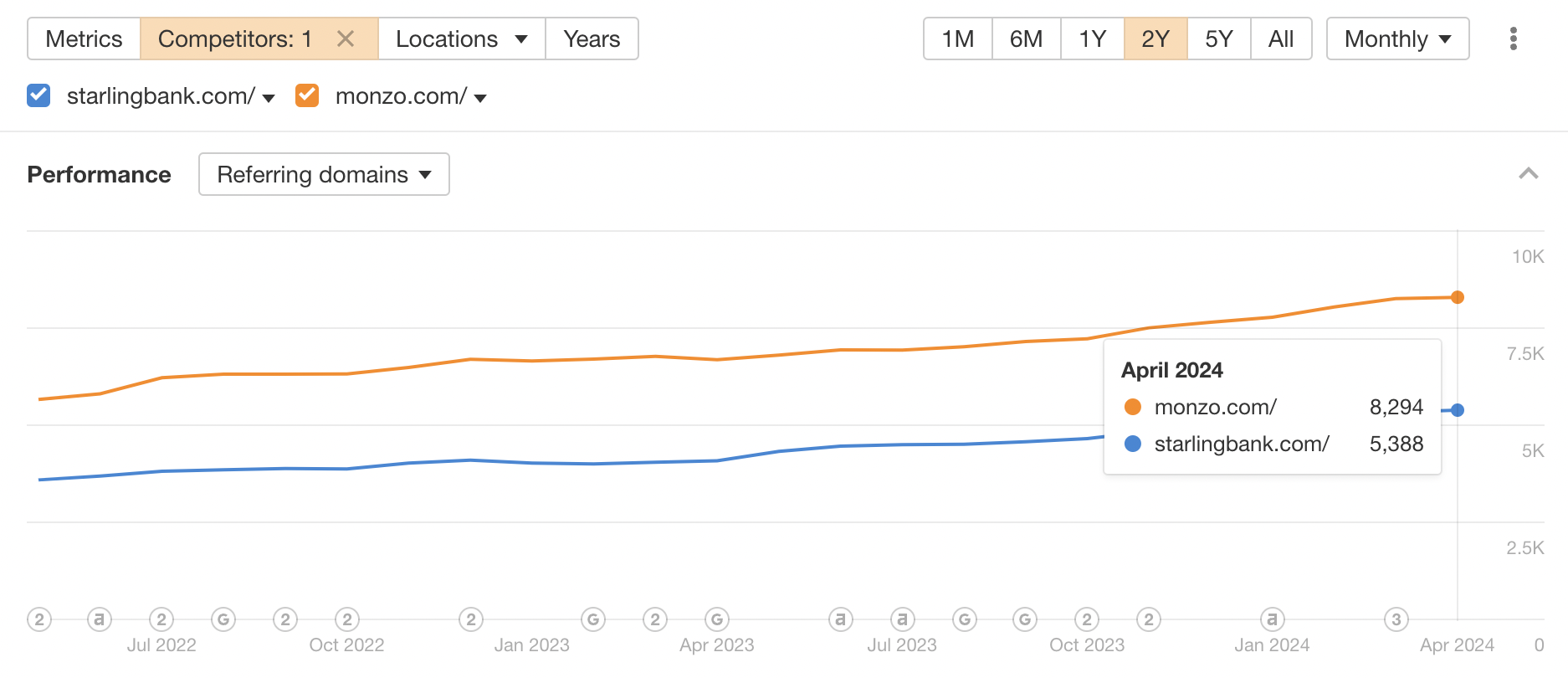
See my post that looks at “Would you still want this link if Google didn’t exist?” to learn my thoughts on relevancy in digital PR.
6. Fix 100+ linked 404s
There are over 250 links that point to 404 pages on the Starling website, and fixing these would mean that the authority from these links isn’t going to waste.
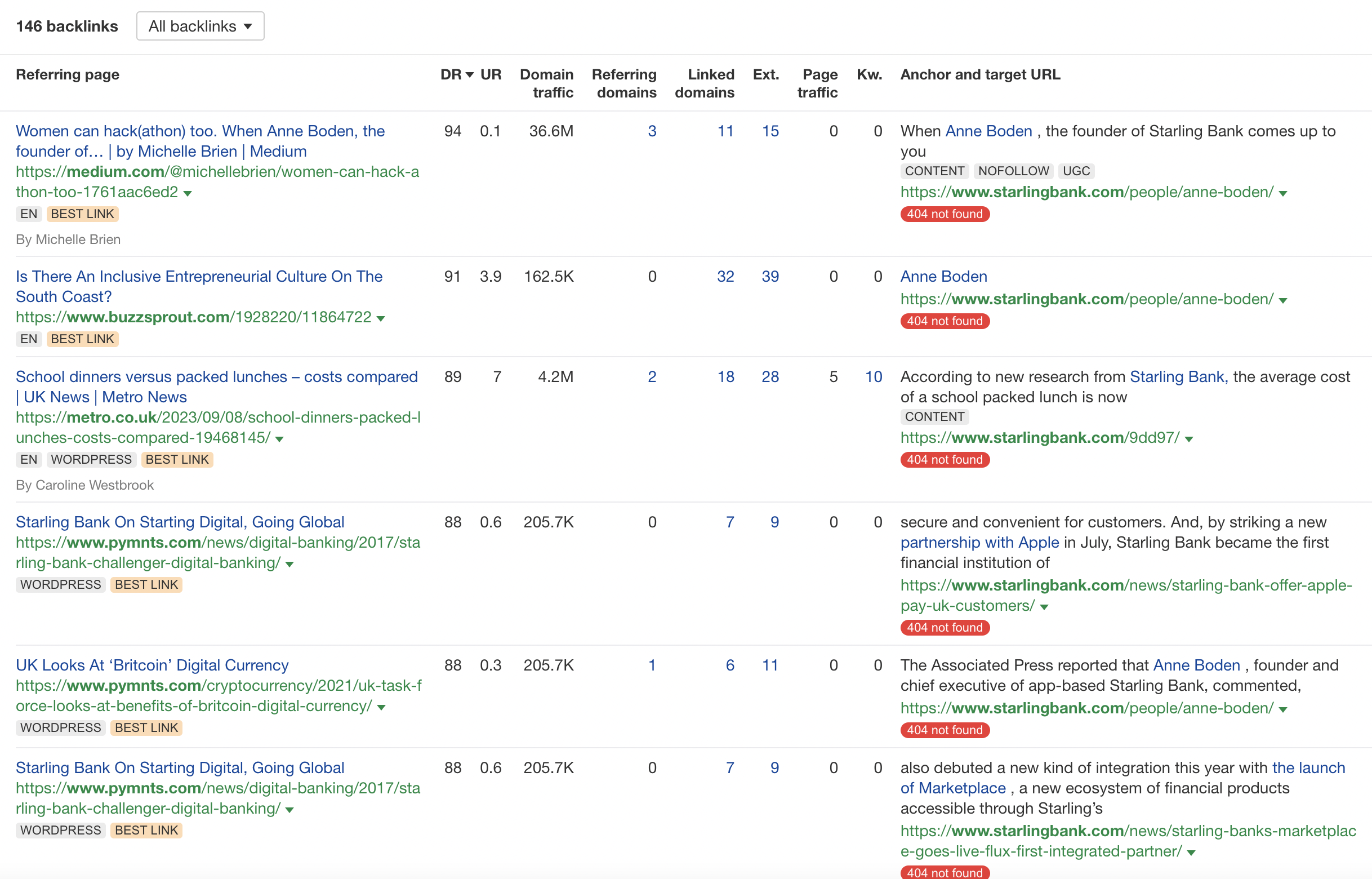
You see, Google ignores links that point to 404 pages. And this means these links are effectively doing nothing to contribute towards the site’s authority or that of individual pages.
Cleaning these up is such an easy fix, too.
But just look at some of the links that are pointing to a dead page right now:
| URL | DR |
|---|---|
| https://metro.co.uk/2023/09/08/school-dinners-packed-lunches-costs-compared-19468145/ | DR89 |
| https://www.pymnts.com/cryptocurrency/2021/uk-task-force-looks-at-benefits-of-britcoin-digital-currency/ | DR87 |
| https://www.computerweekly.com/news/252446374/Starling-raises-the-fintech-stakes-with-banking-as-a-service | DR86 |
| https://www.tenentrepreneurs.org/aboutfff | DR49 |
| https://www.fintechtalents.com/anne-and-tom-my-part-in-their-breakup/ | DR47 |
| https://www.transcendit.co.uk/blog/posts/business-banking-which-digital-banks-are-good-for-startups | DR46 |
This isn’t about the fact that these pages no longer exist and now 404. Every site needs to kill off pages from time to time, but if there are links pointing to these, they need to be 301 redirected to the next best alternative.
Not all of these links pointing to 404s will make sense to redirect, but those that do should be fixed to reclaim as much of the link authority as possible.
Check out my guide on how to find & fix linked 404 pages to learn more about this tactic.
7. Build out ‘statistics’ pages to naturally earn links
Links still matter. There’s no getting away from that.
And the best links are those that are naturally earned over time as a result of producing content that journalists and other content creators want to reference.
A great method for doing this in the finance sector is by building out ‘statistics’ pages. Why? Because there’s a good chance that people searching these types of terms (e.g. small business statistics) are looking for sources to cite within their own content.
Here are a few examples for the term “small business statistics:”
| URL | Links to URL |
|---|---|
| https://www.forbes.com/uk/advisor/business/small-business-statistics/ | 19 |
| https://www.hostinger.co.uk/tutorials/small-business-statistics | 3 |
| https://www.nimblefins.co.uk/business-insurance/small-business-insurance-uk/small-business-statistics-uk | 38 |
| https://www.luisazhou.com/blog/small-business-statistics/ | 31 |
Now I’m often torn on this technique, and looking at the URLs above raises further questions.
What authority, in the wider sense, does Luisa Zhou have around small business statistics? Very little is my guess.
But Starling Bank, a leading provider of business bank accounts? Much more authority.
This is a tactic we’re big fans of here at Digitaloft.
Here’s an example of this working; we produced and launched the ‘First Time Buyer Statistics‘ roundup for Money.co.uk in 2023. That page now has 185 links pointing to it.

There are lots of different pages of this type Starling could create, so long as they’re relevant to the business!
8. Improve internal linking
One of the most impactful SEO tactics you can leverage to drive growth is internal linking.
Making improvements here pretty much never fails to have an impact on rankings, yet so many sites still have an absolute tonne of opportunities to do this better.
And Starling Bank is no exception.
Let’s take the bank’s “current account” page as an example, knowing there’s a big opportunity to push this higher up the first page of the SERPs.
There are opportunities to build internal links to this page from other pages including:
- https://www.starlingbank.com/current-account/compare-best-bank-accounts/
- https://www.starlingbank.com/blog/why-you-should-bank-with-starling/
- https://www.starlingbank.com/blog/five-things-to-talk-about-before-getting-a-joint-account/
- https://www.starlingbank.com/blog/take-control-of-your-finances-budgeting-and-money-insights/
- https://www.starlingbank.com/blog/a-guide-to-our-new-virtual-cards/
These aren’t random pages we’ve found on the site. They’re ones we identified from a search of:
site:starlingbank.com/blog/ current account
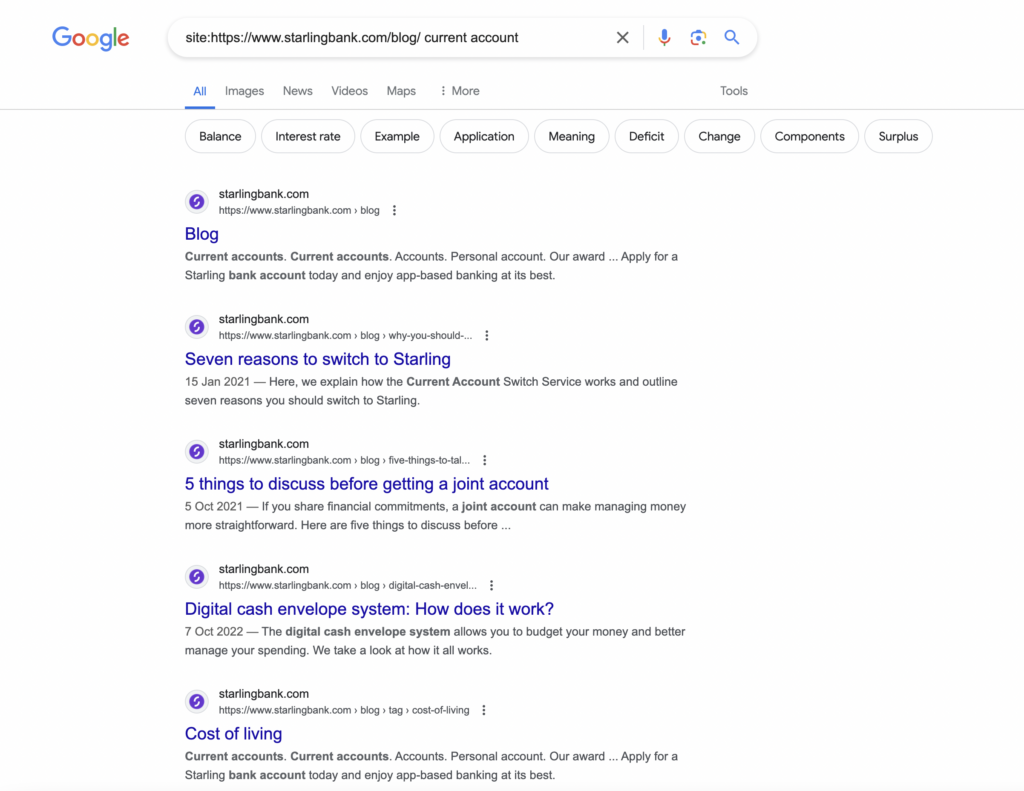
Using search operators to understand which pages on a domain are deemed relevant to a keyword is a simple and effective way of identifying internal linking opportunities. In this case, we’re looking at blog content that provides an opportunity to link.
It’s literally as simple as checking whether these pages link through, using relevant anchor text, to the main current accounts page.
These five above don’t.
And “current accounts” is by no means the only page that could benefit from improved internal linking.
Take five target pages you want to improve the rankings of, block out an afternoon and build internal links. It might be a bit boring, but it works. Every time.
An Opportunity to Accelerate SEO Success
Starling Bank has an opportunity to take the site’s SEO success to the next level in 2024 and catapult organic traffic to an all-time high, both with informational and commercial-intent content.
Whilst these aren’t the only issues that exist, and the fact that those I’ve highlighted aren’t all simple fixes, the opportunity is there.
And I’ve always said that opportunities are there to grab… if you’re not taking that traffic, someone else is.
